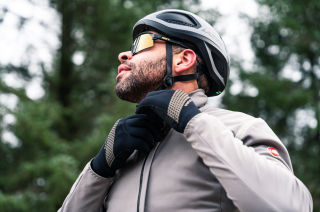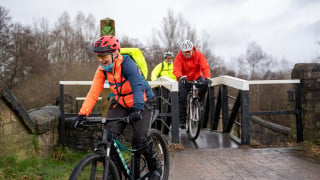Knowledge Level: Intermediate
Whether you are commuting, riding to/from school or university, heading out on the trails, or sticking to the roads, we have some advice to help keep your hands warm and comfortable during your ride.
Winter riding can be just as enjoyable as any other season with the right preparation, with a little planning you can make your ride both enjoyable and warm. Icy fingers can affect your ability to shift gears, brake, or grip the bars, potentially compromising both performance and safety. Here’s how to keep your hands toasty and ready for every ride, no matter the weather in the winter.
General winter riding prep
Play around with layers – find a layering approach that works for you and your body. Start with a thin silk or merino wool liner for insulation, add a mid-layer for warmth, and finish with a windproof or waterproof outer shell. This layered setup also traps air for added insulation and will improve warmth and adaptability.
Avoid tight fits – gloves that are too snug can restrict circulation, making your hands feel colder. Choose gloves with enough room to flex your fingers comfortably. Mittens or lobster-style gloves, which separate your fingers less, can be even warmer while still allowing you to operate gears and brakes.
Warm head, warm hands – keeping your head and ears warm can significantly impact your overall comfort, including your hands. A windproof skull cap, beanie, or winter cycling cap under your helmet will help retain heat. If you really feel the cold air, consider swapping to an aero helmet with fewer vents for extra protection against biting winds.
Fuel - part of keeping yourself warm is remembering to fuel and hydrate correctly. It’s essential to think about what you’re taking with you on your ride. Will you be inside or outside when you stop? How long will you be stopping for? Do you want to bring your own snacks? Easy snacks like energy bars, bananas, or dried fruits are ideal for mid-ride fuel. Also, try using an insulated bottle with a hot drink. Check out Insight Zone for some great snack recipes
Quick tip - double-wrapping bar tape adds insulation against the cold bars and reduces road vibrations.

Before setting off:
It’s the day of your ride and you are starting to get ready! Here are some final pre-ride rituals to ensure your hands stay warm:
Start cosy – you can start your ride with happy hands by warming up your gloves before you head out. Place them on a radiator, give them a quick blast with a hairdryer, or wrap your hands around a warm drink before you head out – whatever works for you.
If you’re riding on consecutive days, ensure your gloves are fully dry before your next ride to prevent any moisture from cooling your hands.
Seal those cuffs – It might seem like a small detail, but properly sealing the cuffs of your jacket or jersey over your gloves can make a big difference in keeping your hands warm. Simply overlap the outer layer with your gloves and tighten any fastenings to create a snug barrier. This simple step helps lock in warmth and blocks out cold air or water, leaving you much more comfortable during your ride.
On the Ride:
Shake it out - Staying active with your hands is essential for keeping them warm and functional during a ride. Shift your grip on the handlebars often, alternating between different positions to maintain good circulation. Periodically, squeeze and relax your hands or give them a quick shake to keep the blood flowing. These small but effective movements can help prevent numbness and stiffness, ensuring your hands remain comfortable and responsive for braking and shifting. With this habit, you'll stay in control and enjoy a smoother ride, no matter the temperature.
Spare Gloves – carrying an extra pair of gloves or liners can make all the difference to your ride, whether for yourself or someone in your group. Pack them in a waterproof bag to ensure they stay dry, no matter what the weather throws at you. If your hands become damp or your gloves lose their insulation during the ride, swapping into a warm, dry pair can feel like a game-changer.
Tactical stops - whether your mid-ride stop is a trail-side bench with a view or a local café, tactical stops can be really beneficial. They give you the opportunity to refuel and recharge, as well as adjust your layering system if you’re getting too warm or cold. If your hands are cold, it’s a good time to grab a warm drink.

After the Ride:
Clean your kit - the part of a ride that no one particularly looks forward to but is unavoidable and vital. Properly maintaining your kit will ensure it will continue to perform and last for the long haul. Mud, moisture, and salt / grit can quickly degrade fabric and components if not removed. Always air dry your gear before storing it and be sure to wash any waterproof items according to the manufacturer’s instructions. Keeping your kit in top condition ensures that it will keep looking after you on the next winter ride.
With a little preparation and the right approach, you can keep your hands warm and comfortable no matter how chilly the ride. Say goodbye to frozen fingers and hello to embracing winter riding.















